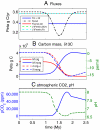Biologically induced initiation of Neoproterozoic snowball-Earth events
- PMID: 21825156
- PMCID: PMC3174660
- DOI: 10.1073/pnas.1016361108
Biologically induced initiation of Neoproterozoic snowball-Earth events
Abstract
The glaciations of the Neoproterozoic Era (1,000 to 542 MyBP) were preceded by dramatically light C isotopic excursions preserved in preglacial deposits. Standard explanations of these excursions involve remineralization of isotopically light organic matter and imply strong enhancement of atmospheric CO(2) greenhouse gas concentration, apparently inconsistent with the glaciations that followed. We examine a scenario in which the isotopic signal, as well as the global glaciation, result from enhanced export of organic matter from the upper ocean into anoxic subsurface waters and sediments. The organic matter undergoes anoxic remineralization at depth via either sulfate- or iron-reducing bacteria. In both cases, this can lead to changes in carbonate alkalinity and dissolved inorganic pool that efficiently lower the atmospheric CO(2) concentration, possibly plunging Earth into an ice age. This scenario predicts enhanced deposition of calcium carbonate, the formation of siderite, and an increase in ocean pH, all of which are consistent with recent observations. Late Neoproterozoic diversification of marine eukaryotes may have facilitated the episodic enhancement of export of organic matter from the upper ocean, by causing a greater proportion of organic matter to be partitioned as particulate aggregates that can sink more efficiently, via increased cell size, biomineralization or increased CN of eukaryotic phytoplankton. The scenario explains isotopic excursions that are correlated or uncorrelated with snowball initiation, and suggests that increasing atmospheric oxygen concentrations and a progressive oxygenation of the subsurface ocean helped to prevent snowball glaciation on the Phanerozoic Earth.
Conflict of interest statement
The authors declare no conflict of interest.
Figures



Comment in
-
Evolution of the ocean's "biological pump".Proc Natl Acad Sci U S A. 2011 Oct 4;108(40):16485-6. doi: 10.1073/pnas.1112236108. Epub 2011 Sep 26. Proc Natl Acad Sci U S A. 2011. PMID: 21949394 Free PMC article. No abstract available.
References
-
- Harland WB. In: Problems in Palaeoclimatology. Nairn AEM, editor. London: John Wiley & Sons; 1964. pp. 119–149.pp. 180–184.
-
- Kirschvink J. In: The Proterozoic Biosphere: A Multidisciplinary Study. Schopf J, Klein C, editors. Cambridge, U.K.: Cambridge Univ Press; 1992. pp. 51–52.
-
- Hoffman PF, Kaufman AJ, Halverson GP, Schrag DP. A Neoproterozoic snowball Earth. Science. 1998;281:1342–1346. - PubMed
-
- Schrag DP, Berner RA, Hoffman PF, Halverson GP. On the initiation of a snowball Earth. Geochem Geophys Geosyst. 2002;3:1036.
-
- Knoll AH. In: The Origin and Early Evolution of Metazoans. Signor P JL, editor. New York: Plenum; 1992. pp. 53–84.
Publication types
MeSH terms
Substances
LinkOut - more resources
Full Text Sources

